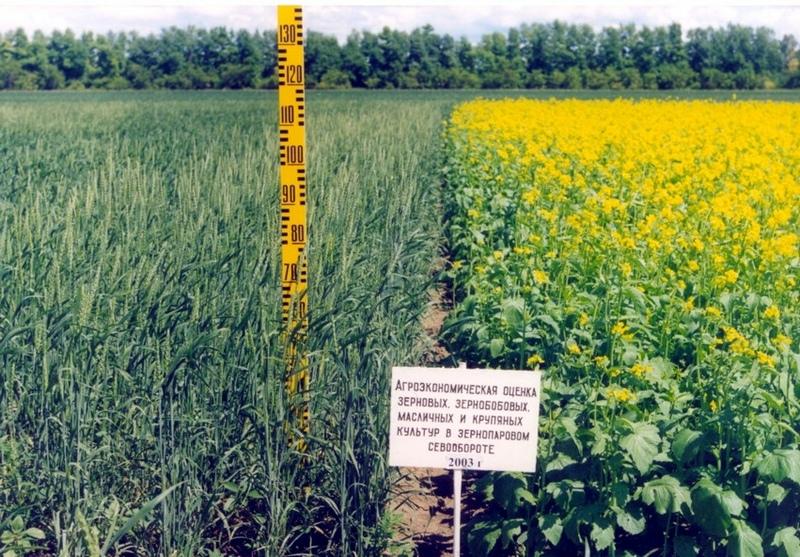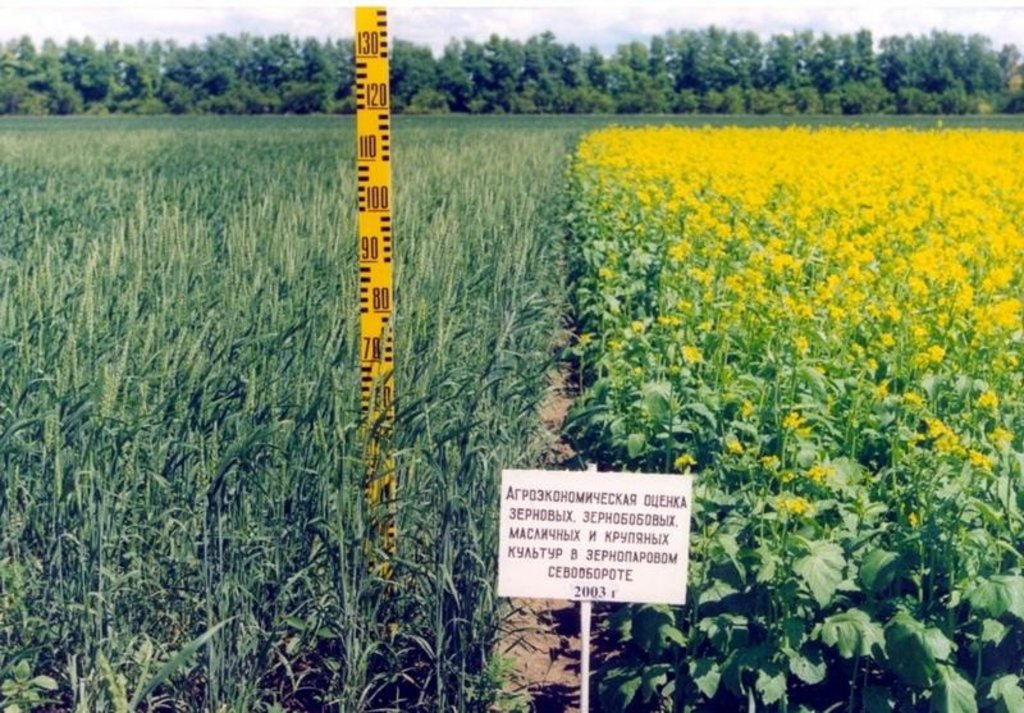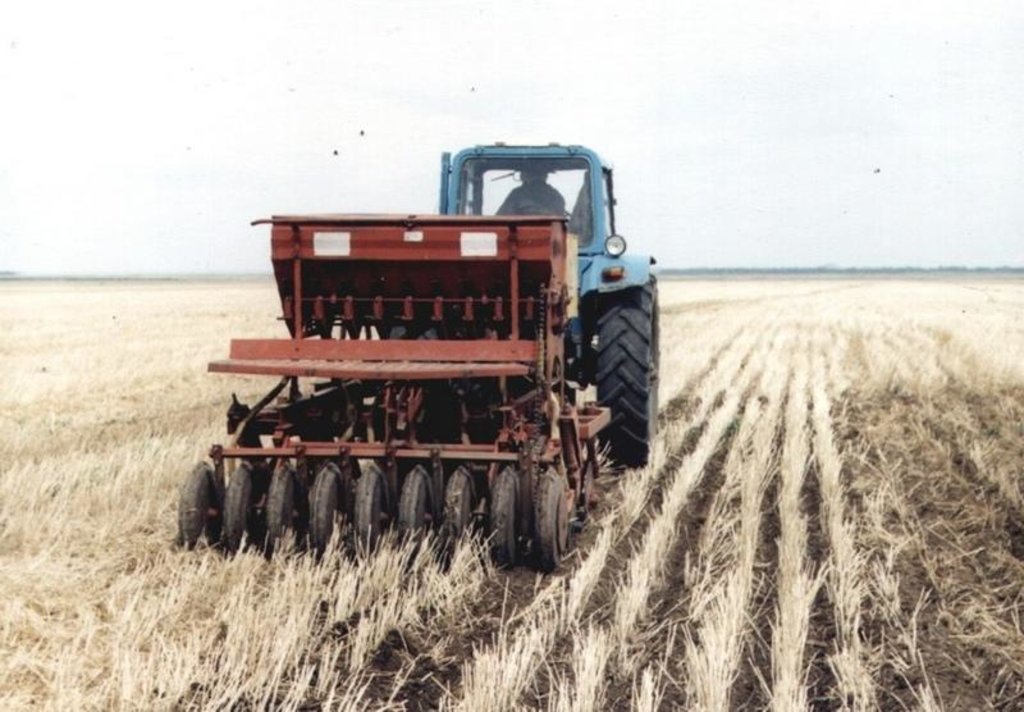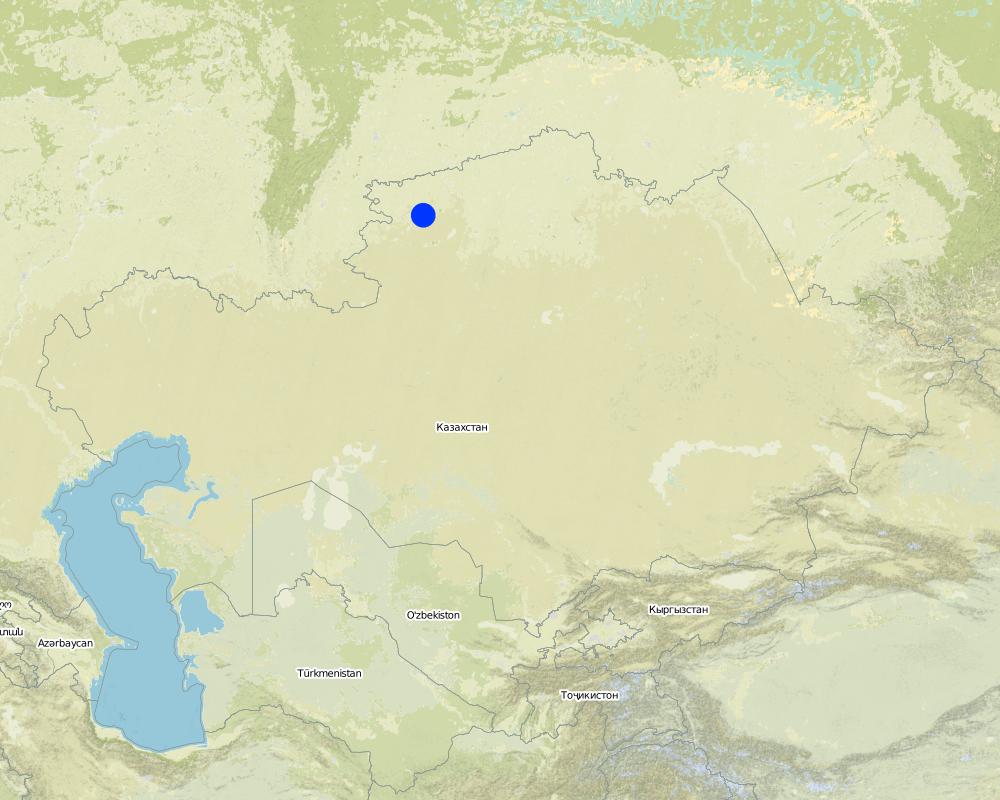Soil-protective minimal technology of the tillage and sowing [คาซัคสถาน]
- ผู้สร้างสรรค์:
- การอัพเดท:
- ผู้รวบรวม: Ervin Gossen
- ผู้เรียบเรียง: –
- ผู้ตรวจสอบ: David Streiff, Alexandra Gavilano
Soil-protective system of agriculture
technologies_1092 - คาซัคสถาน
ดูส่วนย่อย
ขยายทั้งหมด ย่อทั้งหมด1. ข้อมูลทั่วไป
1.2 รายละเอียดที่ติดต่อได้ของผู้รวบรวมและองค์กรที่เกี่ยวข้องในการประเมินและการจัดเตรียมทำเอกสารของเทคโนโลยี
ผู้เชี่ยวชาญ SLM:
Budnikova Taisia
National Ecological Society
คาซัคสถาน
ผู้เชี่ยวชาญ SLM:
Kaskarbaev Jaksenbay Aitanovich
SPC for Crain Husbandry
คาซัคสถาน
ชื่อขององค์กรซึ่งอำนวยความสะดวกในการทำเอกสารหรือการประเมินเทคโนโลยี (ถ้าเกี่ยวข้อง)
Ministry of Agriculture of Kazakhstan - คาซัคสถาน1.3 เงื่อนไขการใช้ข้อมูลที่ได้บันทึกผ่านทาง WOCAT
ผู้รวบรวมและวิทยากรหลักยอมรับเงื่อนไขเกี่ยวกับการใช้ข้อมูลที่ถูกบันทึกผ่านทาง WOCAT:
ใช่
1.5 Reference to Questionnaire(s) on SLM Approaches (documented using WOCAT)
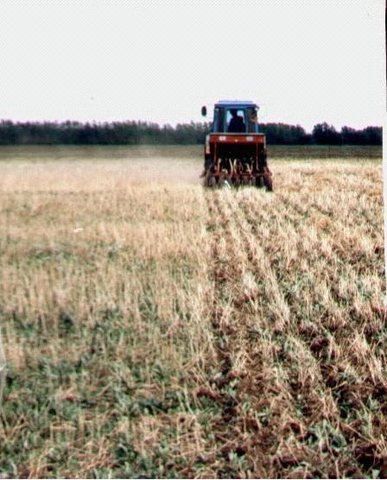
Crop on the stubble background [คาซัคสถาน]
Stubble crop for cultivation of grain crops (spring wheat).
- ผู้รวบรวม: Ervin Gossen
2. การอธิบายลักษณะของเทคโนโลยี SLM
2.1 การอธิบายแบบสั้น ๆ ของเทคโนโลยี
คำจำกัดความของเทคโนโลยี:
The minimal tillage for cultivation of grain crops (the second and third culture after fallow).
2.2 การอธิบายแบบละเอียดของเทคโนโลยี
คำอธิบาย:
The technology is directed on struggle against wind and water erosion.
After harvesting of grain crops on a field it is left stubble background which carries out some functions:
1)Accumulation of moisture.
2)Prevention of water and wind erosion
3)Accumulation of organic in humus layer.
During the spring period on the stubble background there is a sowing of grain crops by the direct or combined seeder there (cultivation, sowing, application of fertilizers, compacting) with covering of seeds on depth of 3,8 centimeters.
After shoots at presence of weeds it is carried out a local tilling of the littered sites of a field.
In the autumn harvesting of the grain is carried out with crushing of strow and formation of the stubble layer.
Productivity of the grain makes 8,6-12,5 c/ha depending on humidity of year.
-fertilized fallow with minimum and chemical tillage;
-sowing of spring rapes on the fallow by seeding-machine “Flexy-Coil” +sowing of winter rye to spring rapes stubble in the second summer half – “direct sowing”
-winter rye of early ripening sorts (August)+ semifallow soil tillage+ fertilizers under sowing of steadfast spring wheat;
-steadfast spring wheat;
2.3 รูปภาพของเทคโนโลยี
2.5 ประเทศภูมิภาค หรือสถานที่ตั้งที่เทคโนโลยีได้นำไปใช้และได้รับการครอบคลุมโดยการประเมินนี้
ประเทศ:
คาซัคสถาน
ภูมิภาค/รัฐ/จังหวัด:
Northern Kazakhstan
ข้อมูลจำเพาะเพิ่มเติมของสถานที่ตั้ง :
Kustanay, Northern Kazakhstan, Akmola
ระบุการกระจายตัวของเทคโนโลยี:
- กระจายไปอย่างสม่ำเสมอในพื้นที่
If the Technology is evenly spread over an area, specify area covered (in km2):
28.0
If precise area is not known, indicate approximate area covered:
- 10-100 ตร.กม.
แสดงความคิดเห็น:
Total area covered by the SLM Technology is 28 km2.
Before disintegration of the USSR the tillage and sowing on the stubble background in 1990 has made the area in 61,4 mill.ha on a steppe droughty zone (chernozem and dark chestnut zone of the USSR).
Map
×2.6 วันที่การดำเนินการ
ถ้าไม่รู้ปีที่แน่นอน ให้ระบุวันที่โดยประมาณ:
- มากกว่า 50 ปี (แบบดั้งเดิม)
2.7 คำแนะนำของเทคโนโลยี
ให้ระบุว่าเทคโนโลยีถูกแนะนำเข้ามาอย่างไร:
- เป็นส่วนหนึ่งของระบบแบบดั้งเดิมที่ทำก้นอยู่ (> 50 ปี)
ความคิดเห็น (ประเภทของโครงการ เป็นต้น) :
from Canada
3. การจัดประเภทของเทคโนโลยี SLM
3.1 วัตถุประสงค์หลักของเทคโนโลยี
- ลด ป้องกัน ฟื้นฟู การเสื่อมโทรมของที่ดิน
3.2 ประเภทของการใช้ที่ดินในปัจจุบันที่ได้นำเทคโนโลยีไปใช้

พื้นที่ปลูกพืช
- การปลูกพืชล้มลุกอายุปีเดียว
- การปลูกพืชยืนต้นที่ไม่มีเนื้อไม้
Annual cropping - Specify crops:
- cereals - rye
- cereals - wheat (spring)
จำนวนของฤดูเพาะปลูกต่อปี:
- 1
ระบุ:
Longest growing period in days: 166; Longest growing period from month to month: May - Sep
แสดงความคิดเห็น:
Major land use problems (compiler’s opinion): Soil-fertility is reduced on 10-25% (humus loss for 50 years).
Deterioration of technique Fertilizers are not brought in full.
Major land use problems (land users’ perception): Dissociation of farms with the average size of an arable land – 60 ha.
Struggle against wind and water erosion is directed on increase of soil fertility and receptions of steady cultures at full protection.
3.4 การใช้น้ำ
การใช้น้ำของที่ดินที่มีการใช้เทคโนโลยีอยู่:
- จากน้ำฝน
3.5 กลุ่ม SLM ที่ตรงกับเทคโนโลยีนี้
- ระบบหมุนเวียน (การปลูกพืชหมุนเวียน การพักดิน การเกษตรแบบไร่เลื่อนลอย)
- การรบกวนดินให้น้อยที่สุด
3.6 มาตรการ SLM ที่ประกอบกันเป็นเทคโนโลยี

มาตรการจัดการพืช
- A2: อินทรียวัตถุในดิน/ความอุดมสมบูรณ์ในดิน
- A3: การรักษาหน้าดิน
แสดงความคิดเห็น:
Type of agronomic measures: cover cropping, mulching, temporary trashlines, legume inter-planting, mineral (inorganic) fertilizers, rotations / fallows, zero tillage / no-till, minimum tillage
3.7 รูปแบบหลักของการเสื่อมโทรมของที่ดินที่ได้รับการแก้ไขโดยเทคโนโลยี

การกัดกร่อนของดินโดยน้ำ
- Wm (Mass movement): การเคลื่อนตัวของมวลดินหรือดินถล่ม

การกัดกร่อนของดินโดยลม
- Et (Loss of topsoil): การสูญเสียดินชั้นบน

การเสื่อมโทรมของดินทางด้านเคมี
- Cp (Soil pollution): มลพิษในดิน
แสดงความคิดเห็น:
Secondary types of degradation addressed: Wm: mass movements / landslides, Cp: soil pollution
Main causes of degradation: other human induced causes (specify) (agricultural causes - Development vergin and lay lands.)
Secondary causes of degradation: land tenure (land subdivision), poverty / wealth (lack of capital)
3.8 การป้องกัน การลดลง หรือการฟื้นฟูความเสื่อมโทรมของที่ดิน
ระบุเป้าหมายของเทคโนโลยีกับความเสื่อมโทรมของที่ดิน:
- ป้องกันความเสื่อมโทรมของที่ดิน
- ลดความเสื่อมโทรมของดิน
แสดงความคิดเห็น:
Also rehabilitation / reclamation of denuded land
4. ข้อมูลจำเพาะด้านเทคนิค กิจกรรมการนำไปปฏิบัติใช้ ปัจจัยนำเข้า และค่าใช้จ่าย
4.1 แบบแปลนทางเทคนิคของเทคโนโลยี
ข้อมูลจำเพาะด้านเทคนิค (แบบแปลนทางเทคนิคของเทคโนโลยี):
Main technical functions: control of raindrop splash, control of dispersed runoff: retain / trap, increase of surface roughness, increase in organic matter, increase of infiltration, increase / maintain water stored in soil, increase in soil fertility
Mulching
Material/ species: straw 100%
Temporary trashlines
Material/ species: stubble 100%
Mineral (inorganic) fertilizers
Material/ species: herbicides
Rotations / fallows
Material/ species: fallows-rape-wheat 100% 2,5 mln seeds for hectar
Zero tillage / no-till
Material/ species: Sowing on a stubble
Minimum tillage
Material/ species: on depth of 3,8 centm
4.2 ข้อมูลทั่วไปเกี่ยวกับการคำนวณปัจจัยนำเข้าและค่าใช้จ่าย
ระบุสกุลเงินที่ใช้คำนวณค่าใช้จ่าย:
- USD
ระบุค่าเฉลี่ยของค่าจ้างในการจ้างแรงงานต่อวัน:
10.00
4.4 ค่าใช้จ่ายของปัจจัยนำเข้าที่จำเป็นสำหรับการจัดตั้ง
| ปัจจัยนำเข้า | หน่วย | ปริมาณ | ค่าใช้จ่ายต่อหน่วย | ค่าใช้จ่ายทั้งหมดต่อปัจจัยนำเข้า | %ของค่าใช้จ่ายที่ก่อให้เกิดขึ้นโดยผู้ใช้ที่ดิน | |
|---|---|---|---|---|---|---|
| แรงงาน | Labour | persons/day/ha | 5.0 | 10.0 | 50.0 | 100.0 |
| อุปกรณ์ | Machine use | ha | 1.0 | 10.0 | 10.0 | 100.0 |
| วัสดุด้านพืช | Seeds | ha | 1.0 | 20.0 | 20.0 | 100.0 |
| ปุ๋ยและสารฆ่า/ยับยั้งการเจริญเติบโตของสิ่งมีชีวิต (ไบโอไซด์) | Fertilizer | ha | 1.0 | 10.0 | 10.0 | 100.0 |
| ค่าใช้จ่ายทั้งหมดของการจัดตั้งเทคโนโลยี | 90.0 | |||||
| Total costs for establishment of the Technology in USD | 90.0 | |||||
แสดงความคิดเห็น:
Duration of establishment phase: 36 month(s)
4.5 การบำรุงรักษาสภาพหรือกิจกรรมที่เกิดขึ้นเป็นประจำ
| กิจกรรม | ช่วงระยะเวลา/ความถี่ | |
|---|---|---|
| 1. | Fallows creating | autumn / in 3 years |
| 2. | Rape sowing + winter rye | early spring, august / in 3 years |
| 3. | Winter rye + semi-fallow + fertilizing | early spring, august / in 3 years |
| 4. | Wheat sowing | early spring / in 3 years |
4.6 ค่าใช้จ่ายของปัจจัยนำเข้าและกิจกรรมที่เกิดขึ้นเป็นประจำที่ต้องการการบำรุงรักษา (ต่อปี)
| ปัจจัยนำเข้า | หน่วย | ปริมาณ | ค่าใช้จ่ายต่อหน่วย | ค่าใช้จ่ายทั้งหมดต่อปัจจัยนำเข้า | %ของค่าใช้จ่ายที่ก่อให้เกิดขึ้นโดยผู้ใช้ที่ดิน | |
|---|---|---|---|---|---|---|
| แรงงาน | Labour | persons/day/ha | 5.0 | 10.0 | 50.0 | 100.0 |
| อุปกรณ์ | Machine use | ha | 1.0 | 10.0 | 10.0 | 100.0 |
| วัสดุด้านพืช | Seeds | ha | 1.0 | 20.0 | 20.0 | 100.0 |
| ปุ๋ยและสารฆ่า/ยับยั้งการเจริญเติบโตของสิ่งมีชีวิต (ไบโอไซด์) | Fertilizer | ha | 1.0 | 10.0 | 10.0 | 100.0 |
| ค่าใช้จ่ายทั้งหมดของการบำรุงรักษาสภาพเทคโนโลยี | 90.0 | |||||
| Total costs for maintenance of the Technology in USD | 90.0 | |||||
แสดงความคิดเห็น:
Machinery/ tools: SZS-2,1, K-700, Kamaz-with tractor carriages PTS-9,3 PTS-12, combine Enisey
Calculation of expenses is made on 1 ha an arable land.
4.7 ปัจจัยสำคัญที่สุดที่มีผลกระทบต่อค่าใช้จ่าย
ปัจจัยสำคัญที่สุดที่มีผลกระทบต่อค่าใช้จ่ายต่างๆ:
Rent of the mechanized means for creation the fallow crop and harvesting of cultures of a crop rotation make the most part of article of expenses on SWS technologies (tractor K-700, combine “Enisey”, automobile – Kamaz seeders – 2,1 carriages to tractors PTC-9,3 PTC-12).
5. สิ่งแวดล้อมทางธรรมชาติและของมนุษย์
5.1 ภูมิอากาศ
ฝนประจำปี
- < 250 ม.ม.
- 251-500 ม.ม.
- 501-750 ม.ม.
- 751-1,000 ม.ม.
- 1,001-1,500 ม.ม.
- 1,501-2,000 ม.ม.
- 2,001-3,000 ม.ม.
- 3,001-4,000 ม.ม.
- > 4,000 ม.ม.
เขตภูมิอากาศเกษตร
- กึ่งแห้งแล้ง
Steppe
5.2 สภาพภูมิประเทศ
ค่าเฉลี่ยความลาดชัน:
- ราบเรียบ (0-2%)
- ลาดที่ไม่ชัน (3-5%)
- ปานกลาง (6-10%)
- เป็นลูกคลื่น (11-15%)
- เป็นเนิน (16-30%)
- ชัน (31-60%)
- ชันมาก (>60%)
ธรณีสัณฐาน:
- ที่ราบสูง/ที่ราบ
- สันเขา
- ไหล่เขา
- ไหล่เนินเขา
- ตีนเนิน
- หุบเขา
ระดับความสูง:
- 0-100 เมตร
- 101-500 เมตร
- 501-1,000 เมตร
- 1,001-1,500 เมตร
- 1,501-2,000 เมตร
- 2,001-2,500 เมตร
- 2,501-3,000 เมตร
- 3,001-4,000 เมตร
- > 4,000 เมตร
ความคิดเห็นและข้อมูลจำเพาะเพิ่มเติมเรื่องสภาพภูมิประเทศ:
Landforms: Wavy plain
Altitudinal zone: 150-340 m a.s.l.
5.3 ดิน
ค่าเฉลี่ยความลึกของดิน:
- ตื้นมาก (0-20 ซ.ม.)
- ตื้น (21-50 ซ.ม.)
- ลึกปานกลาง (51-80 ซ.ม.)
- ลึก (81-120 ซ.ม.)
- ลึกมาก (>120 ซ.ม.)
เนื้อดิน (ดินชั้นบน):
- ปานกลาง (ดินร่วน ทรายแป้ง)
อินทรียวัตถุในดิน:
- สูง (>3%)
(ถ้ามี) ให้แนบคำอธิบายเรื่องดินแบบเต็มหรือระบุข้อมูลที่มีอยู่ เช่น ชนิดของดิน ค่า pH ของดินหรือความเป็นกรดของดิน ความสามารถในการแลกเปลี่ยนประจุบวก ไนโตรเจน ความเค็ม เป็นต้น:
Soil depth on average: Humus horizon up to 80 cm
Soil texture (topsoil): Heavy and average
Soil fertility is medium with a humus content of 4-5%
Topsoil organic matter: 1-5%
Soil drainage / infiltration is medium
Soil water storage capacity is medium at bottom part of the slopes and otherwise low
5.6 ลักษณะของผู้ใช้ที่ดินที่นำเทคโนโลยีไปปฏิบัติใช้
แนวทางการตลาดของระบบการผลิต:
- mixed (subsistence/ commercial)
- ทำการค้า/การตลาด
รายได้ที่มาจากนอกฟาร์ม:
- < 10% ของรายได้ทั้งหมด
ระดับของการใช้เครื่องจักรกล:
- การใช้เครื่องจักรหรือเครื่องยนต์
ระบุลักษณะอื่นๆที่เกี่ยวข้องของผู้ใช้ที่ดิน:
6% of the land users are very rich and own 3% of the land (5).
5% of the land users are rich and own 20% of the land (3).
80% of the land users are average wealthy and own 70% of the land (2).
4% of the land users are poor and own 5% of the land (1).
4% of the land users are poor and own 2% of the land (4).
5.7 Average area of land used by land users applying the Technology
- < 0.5 เฮกตาร์
- 0.5-1 เฮกตาร์
- 1-2 เฮกตาร์
- 2-5 เฮกตาร์
- 5-15 เฮกตาร์
- 15-50 เฮกตาร์
- 50-100 เฮกตาร์
- 100-500 เฮกตาร์
- 500-1,000 เฮกตาร์
- 1,000-10,000 เฮกตาร์
- >10,000 เฮกตาร์
5.8 กรรมสิทธิ์ในที่ดิน สิทธิในการใช้ที่ดินและสิทธิในการใช้น้ำ
กรรมสิทธิ์ในที่ดิน:
- รายบุคคล ไม่ได้รับสิทธิครอบครอง
- รายบุคคล ได้รับสิทธิครอบครอง
สิทธิในการใช้ที่ดิน:
- เช่า
- รายบุคคล
6. ผลกระทบและสรุปคำบอกกล่าว
6.1 ผลกระทบในพื้นที่ดำเนินการ (On-site) จากการใช้เทคโนโลยี
ผลกระทบทางด้านเศรษฐกิจและสังคม
การผลิต
การผลิตพืชผล
แสดงความคิดเห็น/ระบุ:
By means of struggle against erosion and deflation
ผลกระทบทางด้านเศรษฐกิจและสังคมอื่น ๆ
input contstraints
แสดงความคิดเห็น/ระบุ:
High cost
ผลกระทบด้านนิเวศวิทยา
ดิน
ความชื้นในดิน
แสดงความคิดเห็น/ระบุ:
Promotes stubble creation
การสูญเสียดิน
ลดความเสี่ยงของภัยพิบัติ
ความเร็วของลม
แสดงความคิดเห็น/ระบุ:
Promotes stubble creation
ผลกระทบด้านนิเวศวิทยาอื่น ๆ
soil fertility
แสดงความคิดเห็น/ระบุ:
Due to introduction of fertilizers reduces erosion
6.2 ผลกระทบนอกพื้นที่ดำเนินการ (Off-site) จากการใช้เทคโนโลยี
ตะกอนที่ถูกพัดพามาโดยลม
แสดงความคิดเห็น/ระบุ:
Reduces adjournment of melkozem
erosion processes
แสดงความคิดเห็น/ระบุ:
Reduces intensity of erosive processes
6.4 การวิเคราะห์ค่าใช้จ่ายและผลประโยชน์ที่ได้รับ
ผลประโยชน์ที่ได้รับเปรียบเทียบกับค่าใช้จ่ายในการจัดตั้งเป็นอย่างไร (จากมุมมองของผู้ใช้ที่ดิน)
ผลตอบแทนระยะสั้น:
ด้านบวกเล็กน้อย
ผลประโยชน์ที่ได้รับเปรียบเทียบกับค่าใช้จ่ายในการบำรุงรักษาหรือต้นทุนที่เกิดขึ้นซ้ำอีก เป็นอย่างไร (จากมุมมองของผู้ใช้ที่ดิน)
ผลตอบแทนระยะสั้น:
ด้านลบ
6.5 การปรับตัวของเทคโนโลยี
- 11-50%
ถ้ามีข้อมูลให้บอกปริมาณด้วย (จำนวนของครัวเรือนหรือครอบคลุมพื้นที่):
100 households covering 40 percent of stated area
Of all those who have adopted the Technology, how many did so spontaneously, i.e. without receiving any material incentives/ payments?
- 91-100%
แสดงความคิดเห็น:
5% of land user families have adopted the Technology without any external material support
100 land user families have adopted the Technology without any external material support
Comments on spontaneous adoption: survey results
There is a little trend towards spontaneous adoption of the Technology
Comments on adoption trend: At low cost of petroleum products fertilizers small and average farm with pleasure apply SWC technology . Cost of petroleum products and fertilizers sharply changes from year to year
6.7 จุดแข็ง / ข้อได้เปรียบ / โอกาสของเทคโนโลยี
| จุดแข็ง / ข้อได้เปรียบ / โอกาสในทัศนคติของผู้ใช้ที่ดิน |
|---|
|
It is accessible in application How can they be sustained / enhanced? Constantly |
|
Improves agromeliorative conditions How can they be sustained / enhanced? Constantly |
|
Allows to receive guaranteed profit How can they be sustained / enhanced? At presence of means for SWC introduction |
| จุดแข็ง / ข้อได้เปรียบ / โอกาสในทัศนคติของผู้รวบรวมหรือวิทยากรหลัก |
|---|
|
It is traditional for region How can they be sustained / enhanced? Constantly |
|
It is effective as a measure of struggle against wind erosion How can they be sustained / enhanced? At threat of processes of wind erosion |
|
It is effective at struggle against water erosion How can they be sustained / enhanced? At threat of processes of water erosion |
|
Promotes accumulation of a moisture in ground How can they be sustained / enhanced? Constantly |
6.8 จุดอ่อน / ข้อเสียเปรียบ / ความเสี่ยงของเทคโนโลยีและวิธีการแก้ไข
| จุดอ่อน / ข้อเสียเปรียบ / ความเสี่ยงในทัศนคติของผู้ใช้ที่ดิน | มีวิธีการแก้ไขได้อย่างไร |
|---|---|
| Opportunity of application SWC to the limited circles of farmers. | Additional grants investments are necessary for small farms or the sponsor’s help. |
7. การอ้างอิงและการเชื่อมต่อ
7.1 วิธีการและแหล่งข้อมูล
7.2 การอ้างอิงถึงสิ่งตีพิมพ์
หัวข้อ, ผู้เขียน, ปี, หมายเลข ISBN:
Soil protective agriculture Baraev A.I., Moscow, "Floc". Without rotation of the Almaty layer , 2000y, Gossen E.F.
ชื่อเรื่อง ผู้เขียน ปี ISBN:
SPC for Crain Husbandry Shartandy city
ลิงก์และโมดูล
ขยายทั้งหมด ย่อทั้งหมดลิงก์

Crop on the stubble background [คาซัคสถาน]
Stubble crop for cultivation of grain crops (spring wheat).
- ผู้รวบรวม: Ervin Gossen
โมดูล
ไม่มีโมดูล


